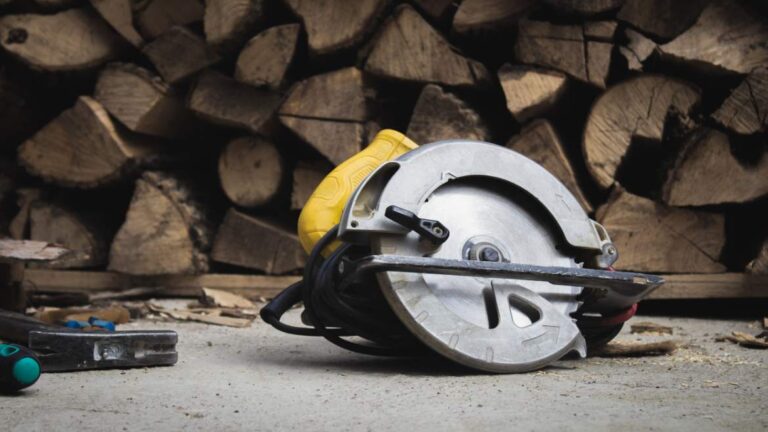When you’re starting a new woodworking project, different resources will often list their own preferred saws. Thus, between a circular saw and a miter saw, which is better for you? In order to cut wood, PVC, and even aluminum, miter saws and circular saws both have disk-shaped, toothed blades. There is some overlap in the capabilities of each saw, but there are also some significant differences. Read this article and you can learn more about these two saws.
What Is A Circular Saw
Mobility is a feature of circular saws. The operator moves the saw forward to cut the wood as the saw and blade are positioned on top of the material.
Some people suggest circular saws as a good first saw because they are adaptable. They have more cutting power than a miter saw and can perform every cut.
Wide boards can be cut with them, as well as dados (cuts that don’t go all the way through the board—a difficult task for miter saws).
This means that circular saws, rather than miter saws, can be used by a beginner woodworker to cut down large pieces of plywood.
In contrast to miter saws, circular saws are more challenging to use. Cutting straight requires practice, and it’s simple to put yourself in danger. Cutting on sawhorses, for instance, can entrap the blade and result in kickback, in which the sawflies backward in the direction of the operator.
Types Of Circular Saws
With a flat plate on the bottom and a blade on the side, all circular saws have the same basic design, but there are three main categories.
- Miniature circular saws have blades under 5″ in diameter, and have a handle that extends behind the motor instead of on top. They can cut a 2×4 or plywood, but they have a limited cutting depth.
- Standard size circular saws range from 7 ¼” to 10″ diameter blades. These are the most typical kind and are excellent for all kinds of cutting tasks. Track saws are a special kind of circular saw that runs on a dedicated track system for more straight, accurate cuts. In most cases, track saws can replace a table saw, circular saw, and miter saw despite being much more expensive and providing finish-quality cuts.
Pros And Cons
Pros
- Versatility
As one of the most practical workshop tools, the circular saw is very adaptable. It can be used to make various cuts and practically any material, including metal, pipes, tiles, stonework, plastic, and sheets of plywood can be cut through.
You are free to use it wherever you need to work, including the attic and your workplace. Every project you want to work on can be completed as long as you have the appropriate blade.
- Rip Cutting And Long Cutting
A circular saw is excellent for long and rips cuts. If you need to cut through the length of a longboard, this saw is the ideal choice for you. The circular saw can also be used to split a plywood sheet in half.
- Great For Straight Cuts
A few straight cuts are required for the majority of the woodworking project, in addition to the few curved cuts, you’ll make.
- Comparatively, Cost-effective
A circular saw can be used to make any cut that a miter saw can. In addition to the variety of cuts it can perform, it is also less expensive than a miter saw. So, a circular
saw ought to be your first choice of the saw before you go for a miter saw.
Cons
- Less Perfect For Making Curved And Angular Cuts
Even though you can make curved and angle cuts with a circular saw, you’ll find that it doesn’t always result in perfectly straight lines. Angles that are sloppy are frequently produced.
- Cuts With Jagged Edges
Tear-outs are a possibility with a circular saw. The edges are equally broken up as a result. This is primarily due to its toothed blade. If you have a lot of trimming tasks already, a circular saw is not the best option. Use a saw with a fine-tooth blade if you want to get a smoother cut in this kind of circumstance.
- A Circular Saw Is Risky
A circular saw is risky because it can cut through any material. They are prone to cuts, and if you use the saw carelessly, you could sever a branch.

What Is A Miter Saw
It’s important to have a clear understanding of what a miter saw is and how it looks before learning the differences between miter saws and circular saws. In a miter saw, a hinged saw that lifts up vertically away from the base on a big arm is attached to a stationary base.
The saw blade is round, and it’s typically used to make crosscuts and miter cuts in wood, plastic, or even metal, depending on the equipped blade.
On the base of the saw, the target material is positioned up against a metal obstruction that is frequently referred to as a fence. While the user grips the handle on the saw arm and holds the trigger down to activate the blade, the fence helps to keep the material straight and in place.
The miter saw makes precise cuts through metal corner rounds, plastic pipes, and wooden beams by lowering the spinning blade to the material.
Types Of Miter Saws
Let’s discuss a few different miter saw varieties. All of these features are present in one saw!
- Single bevel – A single bevel miter saw allows you to make both miter and bevel cuts in the same direction.
- Double bevel miter saw – The double bevel miter saw can make bevel cuts in both When you need to make numerous angled cuts, this feature expedites the process. Find out here what the distinction between a single bevel and dual bevel miter saw is!
- Compound miter saw – A compound miter saw allows you to make compound cuts. Making a miter cut and a bevel cut at the same time is known as a compound cut.
- Sliding miter saw – Rather than having the blade drop straight down, this style of miter saw allows it to slide along a bar. Sliding miter saws are capable of cutting wider boards than non-sliding models.
Pros And Cons
Pros
- Precise Cuts
Miter, cross, and bevel cuts made with a miter saw are precise. You don’t need a guide to get an accurate measurement, unlike the circular saw. All you have to do is the angle the saw correctly.
- Tight-fitting Seams
When you need to cut a few awkward joints for moldings, a miter saw works wonders. For window or door trims, it can equally deliver an accurate cut. A miter saw similarly offers precise cuts through crowns and baseboards.
- Fast And Simple Process
Using a miter saw will enable you to get the desired outcome without the need to gauge and measure the material. Using a miter saw would make any task much simpler and quicker, whether you wanted to make one of the four types of cuts, install trim in your home, or make picture frames.
- Saves Time
With a miter saw, you can cut more expansively. By using the miter saw, which makes cutting large boards much easier, you can save a lot of time. Additionally, miter saw cutting is quick when using the automated blade, particularly when using a compound miter saw. It enables you to quickly cut through the workpiece.
- Easily Cut Bevel And Cross Cuts
It is specifically designed to make angled and beveled cuts. The miter saw performs well when you need to provide bevel, compound, and crosscuts even though it is less versatile than the miter saw. Any of these cuts could be made with ease using a variety of miter saw models.
- Safety
A miter saw is less dangerous than a circular saw, which can make cuts. Inside the reach of the arm where it is set up, the blade only moves upward and downward.
With this saw, you hardly ever experience kickback, and if you wear your safety goggles, your biggest concern won’t be that the blade will accidentally amputate your fingers.
Cons
- Less Versatile
Because miter saws are stationary, they are less adaptable than circular saws. Basically, you transport the material to the mounting location where you want to cut it. As a result, the variety of cuts you can make with a miter saw is reduced.
The main advantages of a miter saw, including the simplicity with which all four types of cuts can be made, come with a drawback. Basically, it only performs these kinds of cuts. In other words, it only makes the cuts for which it was intended and nothing else.
- Classier And More Costly
Compared to circular saws, miter saws are more expensive. A miter saw is referred to as a special tool because it can make all four types of cuts, and because of this, its price is higher because of how useful its cuts are.
A miter saw can cost up to three times as much as a circular saw, so they are not common tools found in most garages and workshops.
- Occupies Space
Because miter saws are stationary, you must set aside some workshop space for them. It might not be practical if you have a small woodworking shop because it would take up a lot of room.
You must bring the wood you want to cut to them according to their stationery design. A few tabletop models can be moved. They are not, however, portable tools that you can use in different rooms.
Comparing Circular And Miter Saws What To Look Out For
Making an informed decision for your house renovations will depend on the following factors given the wide range of options available in each category:
Power
They are motorized tools, so how much power they consume determines how effectively they can cut through lumber. A tool with more power would allow you to cut through more stacks.
However, if you’re starting a project at home, the quantity might not be a major concern. Find a saw that can handle your needs with a power level that is reasonable.
Blades
The range of cuts you can make can vary depending on the blade type and diameters. For home use, a saw with a blade diameter of 6 to 10 inches is typically advised. You can decide by looking at the project you have in mind or by purchasing a basic tool to buy blades as you require them.
Safety Features
Every model will have a unique set of safety features as well as optional attachments that may be supported. Knowing what safety measures to take will help you protect both yourself and your saw from harm.
Precision
While circular saws will need additional measurement tools to increase their precision, many miter saws come with LED or laser guides to improve accuracy. Depending on your needs, you should also think about clamps and other stability boards.
Brand
Choose a reputable option whenever you can, whether you’re buying new or used. Selecting a reputable brand is the first step in making sure you’re making the right investment for these expensive tools.
Which One Should You Choose
In the end, neither option would be a bad choice. The more adaptable choice, i.e., the circular saw.
The circular saw can ultimately make all the cuts a miter saw can—with more flexibility—though you may need to practice and take additional measurements. It’s an easy winner because you have more variation in its power, accuracy, cutting depth, and cut types.
Through the use of the proper blade and configuration, you’ll also be able to cut through a variety of materials, including stone, wood, and metal.
In addition to doing everything a miter saw can, it is very useful for quickly cutting small boards or plywood used in various projects. Additionally, ripping and making dados will cover you in almost every type of cut you’d require.





